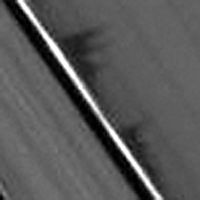
It’s been a while since I posted an image of my favorite moon of Saturn, but while looking through some recent raw images returned by the Cassini spacecraft I spotted it: Daphnis, the little sculptor shepherd moon!
While lacking the hazy mystery and colors of Titan and the dramatic surfaces found on Dione, Rhea, Mimas and many of Saturn’s larger icy moons, little Daphnis has always fascinated me… mostly because it really likes to show off its influence on the particles within the rings. As Daphnis orbits Saturn within the 26-mile-wide Keeper gap at the far edge of the A ring its gravity sets up rippling waves in the rings, both before and behind it (because gravity doesn’t care whether you’re coming or going.) Eventually these waves settle back down, but at their highest they can extend a mile or two above and below the ring plane!

This effect was most pronounced during Saturn’s spring equinox in August 2009, when sunlight was striking the rings edge-on and creating strong shadows from any areas of relief.
Imagine how dramatic that would look if you were nearby, positioned just above the rings as the 4-mile-wide moon approached and hurtled past.
Like Prometheus, shepherd moon of the ropy F ring, Daphnis is little but has a big effect on the icy bits that comprise Saturn’s iconic rings.
The picture above is a crop of a raw image acquired by Cassini on November 11, 2012 from a distance of 336,952 miles (542,271 kilometers). Some adjusting was done to enhance contrast and details of the moon and rings.
(Image: NASA/JPL/Space Science Institute)
ALSO: for a video of the entire sequence of shots, check out Bill Dunford’s Riding With Robots post here.
Look at those lovely ripples! Great photograph.
LikeLike
Thinking of the effects of gravitational compression upon the ice and dust particles in the superconducting temperatures present … and wondering after the ‘side effects’? How might they alter or focus the electromagnetic flux – read tribo electric current so dominant in Saturn’s mag. field? Ring lightning anyone? The Earthly comparison of lightning at 53,540 degrees Fahrenheit compared to Saturn’s MUCH higher voltage potential… equates to what possible chemosynthesis?
LikeLike
Saw Ken Burn’s latest entry concerning ‘the Dust Bowl’ back in the late 30’s. Witness’ describe tribo electric/static electric charges building during the dust storms, which knocked people on their tush with a 6 inch spark, when reaching for a car door….
LikeLike
That’s true… all the fine particles in the dry air built up quite a unipolar charge on metal objects like car doors and fences. I have heard anecdotes of some people/animals dying of heart failure after such a charge, but I don’t know if that’s true or not.
LikeLike